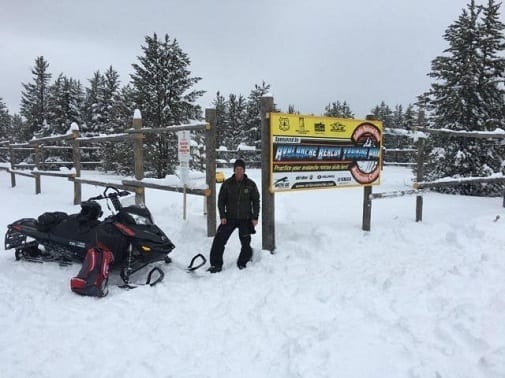Avalanche Awareness Tips

Avalanche Beacon Park in West Yellowstone Montana.
With heavy snow in our area, avalanches are a possibility throughout the winter season. If you love winter recreation in West Yellowstone, taking a few simple precautions before you venture out can mean the difference between life and death.
Doug Chabot, Director of the Gallatin National Forest Avalanche Center, says that groomed snowmobile and ski areas in town are safe, but once you venture off of these trails you may end up in avalanche-prone terrain. “Avalanche terrain is any steep, open slope with snow on it,” Chabot explains, “and there’s a lot of these around!”
So how can you be as safe as possible when riding, skiing, or even snowshoeing in our beautiful backcountry areas? Chabot provided some key tips:
- Check the avalanche report. This report can be found at http://www.mtavalanche.com/advisory and is updated frequently as weather changes. Many things can influence the potential for avalanches, including snowfall and temperature
- Hire a Guide. There is a selection of companies in the area that can not only rent out equipment, but can also offer guide service. Contact the West Yellowstone Chamber for information: (406)646-7701.
- Take an Avalanche Safety class. These classes can provide a wealth of information. If you plan on frequent winter backcountry trips, or just want to put your mind at ease for a specific trip, the Gallatin National Forest Avalanche Center has the class for you. They offer a FREE 1-hour Avalanche Awareness course, as well as more in-depth workshops complete with field components. You can find more information on upcoming classes and registration here.
- Always travel with a partner. If one of you does get injured or caught in an avalanche, having a partner can greatly increase your chances of survival. They will be able to help you on the spot or go get help, and you could do the same for them in the event of an emergency.
Whether you take a class/hire a guide or not, you and your partner(s) should always carry some crucial pieces of equipment, including:
- An avalanche transceiver. Each person in the party should carry a transceiver, so if one or more members of the group becomes separated the pulsed radio signal can assist in locating them. For more information on how transceivers work and how to to choose a transceiver, see this article from REI.
- A shovel. There are lightweight foldable and collapsible shovels designed specifically to be carried on or in a backpack for backcountry use.
- A probe. This is a long folding pole that looks similar to a tent pole. Once it assembled, it can be used, often in conjunction with an avalanche transceiver, tohelp locate a person that is buried under snow.
This equipment will help facilitate rescue if you or someone you’re skiing or riding with do become buried in an avalanche. All of the items above can be found at many outdoors stores as well as online at popular retailers such as amazon.
We encourage everyone to get out and enjoy our beautiful forests and mountains as much as possible, but always be sure to travel safe so you can venture out again and again.
Special thanks to Doug Chabot and the Gallatin National Forest Avalanche Center for the information they shared for this article and for their continuous work on avalanche awareness.
AUTHOR: MONIKA ROGERS